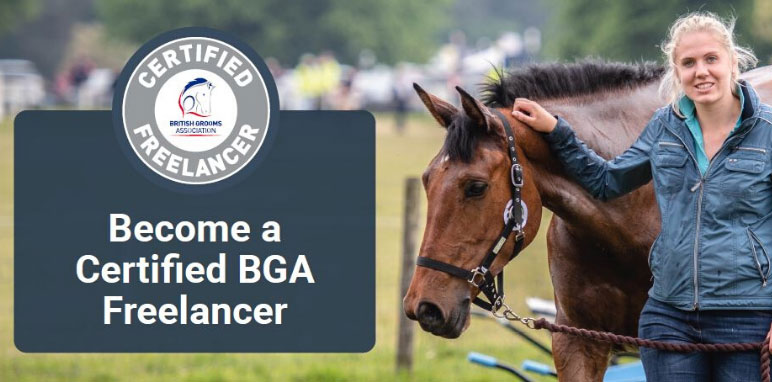- Join Now
- Login
- Member Zone
- Your Career
- Freelancing
- International Grooms Association
- BGA Training
- Healthy Yard Healthy Horses
- Transporting horses
- Brexit
- Safe workplace
- Student Zone
- Member Discounts
- BG Magazine
- Member services
- My employment
- Am I employed correctly
- Grooms Minds
- Safeguarding
- Legal Helpline
- BGA guide to the National Minimum Wage
- Training & Careers
- BGA CV Creator
- Horse groom training
- Where to Train
- BGA E Learning
- Career choices
- Change to Racing
- First Aid training for grooms
- Parents
- Grooms Jobs
- Grooms Life
- About
- News
- Contact


Heatwaves are happening around the world, including the UK, (yes that is right, we are due a heatwave), - thanks to climate change, they're getting hotter and longer. Heatwaves mean heat stroke and other heat-related illnesses will be on the rise. We have gathered some information from the British Red Cross and the NHS to help you spot heat stroke symptoms, along with tips to prevent heat stroke and what to do when someone you know gets heat stroke. Heatstroke happens when the body is unable to cool itself by sweating. It can become extremely dangerous and can develop with little warning. A person suffering from it could become unresponsive within minutes of feeling unwell. Heat stroke can happen when you're exposed to very high temperatures, especially if you're not used to them. Exercising in the heat and wearing excess clothing that prevents sweat from evaporating easily. Drinking alcohol and becoming dehydrated by not drinking enough water will increase your chance of heatstroke. Anyone can be at risk from heatstroke, but young children and older people tend to be most at risk. People with certain health conditions are also at greater risk. These include certain chronic illnesses such as heart or lung disease, or diabetes. Heat exhaustion happens when your body fights to maintain its core temperature - 37.5C. When the surrounding environment is hotter than that, your body grows tired and heat exhaustion sets in. If heat exhaustion is not treated, it can become heat stroke, which is a lot more serious. During periods of hot weather and heatwaves it's important that you take care of your health. As well as the risk of heat exhaustion and heatstroke, there are other health risks to be aware of. Make sure you are taking precautions to protect yourself. If someone is suffereing from heat stroke, you need to lower their body temperature quickly and get them to a hospital. The BGA website has a dedicated library of information about professional horse care, yard maintenance and management, as well as some useful tips on how to look after yourself whilst working as a groom. Check out our Healthy Yard, Healthy Horses section of our website for more information. Join 1000’s of other grooms and belong to your professional association. Preventing heat stroke in humans
16th August 2023

What is heat stroke?
What causes heat stroke?
Who's at risk from heat stroke?
What's the difference between heat stroke and heat exhaustion?
Symptoms of heat exhaustion
Symptoms of heat stroke
It's vitally important to spot the signs of heat stroke early.
Preventing heat exhaustion and heat stroke
suspect heat stroke?
Healthy Yard, Healthy Horses, Healthy You
BLOG ARCHIVE
- 2025 (13 ENTRIES)
- 2024 (52 ENTRIES)
- 2023 (60 ENTRIES)
- 2022 (35 ENTRIES)
- 2021 (24 ENTRIES)
- 2020 (19 ENTRIES)
- 2019 (45 ENTRIES)
- 2018 (36 ENTRIES)
- 2017 (7 ENTRIES)
What the personal accident policy covers you for:
- Whilst at work
- All stable duties – mucking out, grooming, washing off, turning out
- Clipping
- Riding – including hacking and jumping
- Hunting
- Lunging
- Breaking in
- Holding horse for a vet and other procedures
- Travelling horses both in the UK and abroad
- Competing in line with your job including: jumping, dressage, eventing
- Injuries that may happen to you whilst you are teaching - but you must also be grooming as part of your duties and not be a sole instructor
What the personal accident policy doesn’t cover you for:
- Riding in a race, point to point or team chase
- Stunt Riding
- Accidents occurring whilst travelling to and from work
- Riding and competing your own horse (but you can upgrade when applying for membership to include this)
- Public Liability – this is a separate insurance policy - the Freelance Groom Liability Insurance
- Care Custody and Control – this is a separate policy - the Freelance Groom Liability Insurance
If you require additional cover then please contact KBIS directly.
| GROOM | RIDER | EMPLOYER | |
|
When you are working for other people you do most of the following; muck out, turn out/catch in, tack up, groom horses, exercise Horses (including hacking, jumping and schooling), in the care of your employer/client. |
|
|
|
| Predominantly ride horses for other people including schooling, exercising and competing. | NO |
YES |
YES |
| Provide grooming services for someone else either full time or on a freelance basis i.e. an employer or a client. | YES |
NO |
NO |
| Employ staff – have an employers liability policy in your name | NO | NO | YES |
| Buy and sell horses | NO | YES | YES |













